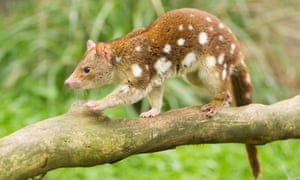Extract from The Guardian
Targeted genetics will help a threatened species spurn a poisonous toad meal
Australia’s northern quoll, one of the world’s rarest carnivores, has
developed a feeding habit that puts its very existence in peril. The
squirrel-sized marsupial turns out to have a fondness for the poisonous
flesh of invasive cane toads, introduced into Australia in the 1930s.
And this appetite has wiped out vast numbers of the species across the
country. As a result, the northern quoll is now considered to be
nationally endangered.
But scientists have launched a remarkable project aimed at saving the little nocturnal hunters. They have pinpointed an isolated group of quolls that have evolved an aversion to cane toads and, instead of munching meals of their venomous flesh, give cane toads a wide berth and seek other prey.
Finding that the toad-aversion trait is inherited, the researchers are attempting to breed new populations of toad-smart quolls in other areas of Australia and so save the species. Early results from trials by Melbourne University suggest that the technique, called targeted gene flow, could be used to save other endangered species.
Last year the researchers released a mixture of normal, vulnerable quolls and toad-smart ones on Indian Island, off Australia’s Northern Territory, to see if the quolls would interbreed and their youngsters survive. Indian Island is known to be infested with cane toads.
Earlier this year, returning to Indian Island, they found that a small number of quoll offspring had survived, indicating that the adults had bred with each other and the surviving offspring must have picked up the toad-aversion trait and not eaten them.
“Being born on the island and surviving to adulthood means these quolls received toad-smart genes and do not eat toads,” researcher Ella Kelly, of Melbourne University, told the Observer. “This shows that targeted gene flow can work.”
The result has been welcomed by conservationists, who believe the technique – which involves pushing a new, protective trait through an at-risk population – could save many other endangered creatures and plants. Essentially this is a way to fast-track evolution.
Other species that could benefit include the Tasmanian devil, which is threatened by facial tumour disease, and coral reefs, many of which are affected by warming waters. In both cases, resistant species could be used to breed in new traits to help survival.
However, the introduction of species to counter biological problems has a tricky record, as demonstrated by the cane toad itself. They were introduced to Australia from South America in an attempt to control grey-backed cane beetles, which were destroying sugar cane crops, a major source of income for Australia.
The toads were supposed to eat the beetles but multiplied so rapidly that there are now more than 200 million in Australia. They have spread across the country, bringing disease to native species, and their flesh has proved deadly to many native carnivorous species, the quoll included. By contrast, cane beetle numbers have been unaffected.
But scientists have launched a remarkable project aimed at saving the little nocturnal hunters. They have pinpointed an isolated group of quolls that have evolved an aversion to cane toads and, instead of munching meals of their venomous flesh, give cane toads a wide berth and seek other prey.
Finding that the toad-aversion trait is inherited, the researchers are attempting to breed new populations of toad-smart quolls in other areas of Australia and so save the species. Early results from trials by Melbourne University suggest that the technique, called targeted gene flow, could be used to save other endangered species.
Last year the researchers released a mixture of normal, vulnerable quolls and toad-smart ones on Indian Island, off Australia’s Northern Territory, to see if the quolls would interbreed and their youngsters survive. Indian Island is known to be infested with cane toads.
Earlier this year, returning to Indian Island, they found that a small number of quoll offspring had survived, indicating that the adults had bred with each other and the surviving offspring must have picked up the toad-aversion trait and not eaten them.
“Being born on the island and surviving to adulthood means these quolls received toad-smart genes and do not eat toads,” researcher Ella Kelly, of Melbourne University, told the Observer. “This shows that targeted gene flow can work.”
The result has been welcomed by conservationists, who believe the technique – which involves pushing a new, protective trait through an at-risk population – could save many other endangered creatures and plants. Essentially this is a way to fast-track evolution.
Other species that could benefit include the Tasmanian devil, which is threatened by facial tumour disease, and coral reefs, many of which are affected by warming waters. In both cases, resistant species could be used to breed in new traits to help survival.
However, the introduction of species to counter biological problems has a tricky record, as demonstrated by the cane toad itself. They were introduced to Australia from South America in an attempt to control grey-backed cane beetles, which were destroying sugar cane crops, a major source of income for Australia.
The toads were supposed to eat the beetles but multiplied so rapidly that there are now more than 200 million in Australia. They have spread across the country, bringing disease to native species, and their flesh has proved deadly to many native carnivorous species, the quoll included. By contrast, cane beetle numbers have been unaffected.

No comments:
Post a Comment